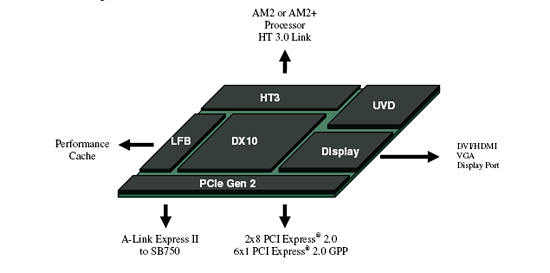780G, err 790GX Northbridge

The biggest change AMD made in designing the 790GX is an increase in core clock speed from 500MHz to 700MHz. In essence, AMD is speed binning the 780G chipsets and those that pass end up with a 790GX silkscreen stamp. Due to the improved performance, the graphics processor also has a name change bump from Radeon HD 3200 to, wait for it, Radeon HD 3300.
The 790GX still utilizes a 55nm TSMC half-node process with transistor counts hitting 205 million. The Northbridge contains 26 lanes of PCI Express 2.0 connectivity with 16 lanes reserved for graphics via a single x16 link or a dual-x 8 CrossFire configuration. Six lanes are available for x1 links for expansion slots or onboard peripherals. AMD reserves the remaining four links for use in the A-Link Express II interface to the SB750 Southbridge.
Hybrid CrossFire returns but support is still limited to the HD 2400 and 3400 based cards. The improved clock speeds of the HD 3300 and performance cache allows a user with a HD 3470 to get performance near that of a HD 3650. The problem is that most HD 3470 cards are selling for around $50 and recent price reductions have brought the price of the HD3650 down to $65, in essence negating the previous price to performance advantages. We doubt anyone will take advantage of this feature since the chipset is targeted primarily for the performance sector where most users will take advantage of a single performance oriented card like the HD 4850 or a CrossFire configuration instead of Hybrid CF if the integrated graphics were not fast enough.
Sideport Memory returns energetically in the 790GX products, this time at the request of AMD. While an option on the 780G boards, AMD has persuaded the motherboard suppliers to include sideport memory in at least one 790GX product from their lineups. Along with this inclusion comes a new name, Performance Cache. The performance cache resides on a 16-bit memory interface that can utilize DDR2 or DDR3 memory. The majority of motherboard makers will use DDR3-1333 in a 128MB configuration. While performance between DDR2 and DDR3 is about the same in this particular application, DDR3 offers additional power savings.
Depending on the processor and HT Link utilized, sideport memory will generally improve performance across the board up to 5% - not just in games, but in video decoding capabilities as well. Besides performance improvements resulting from the local frame buffer instead of shared system memory, the new driver design allows improved Deep Sleep capabilities with the active frame buffers being stored in the performance cache.
As with the 780G, the 790GX AMD features Unified Video Decoder 2.0 (UVD 2.0) capabilities that include hardware acceleration for decoding VC-1, H.264 (AVC), WMV, and MPEG-2 sources up to 1080p resolutions. Advanced de-interlacing is available when using a Phenom processor. HDMI 1.3 compliance continues with xvYCC color space support and 4:2:2 capabilities. On the audio side, the HDMI interface offers support for 2-channel LPCM, Dolby Digital 5.1, or DTS 5.1. AMD still does not support Multi-Channel LPCM and it continues to be a thorn in our side.
Rounding out the video capabilities of the 790GX is analog output, DVI/HDMI interfaces, internal or external TMDS, and integrated DisplayPort capabilities. The HD 3300 features dual independent displays that allow resolution, refresh rates, and display data to be completely independent on the two display paths. AMD provides HDCP support with on-chip key storage for DisplayPort, DVI, or HDMI interfaces but it is regulated to a single interface during playback operations. ATI SurroundView is fully supported when utilizing a Radeon based discrete card that allows the system to drive up to four monitors.
The Radeon HD 3300 graphics processor features a DX10 compliant unified shader model 4.0 graphics core. This architecture contains 40 stream processors from two shader SIMDs. The core features 128-bit floating point precision for all operations, a command processor for reduced overhead, DXTC and 3Dc+ texture compression, texture support up to 8192x8192, and a fully associative texture and Z/stencil cache.
The single texture and ROP units are capable of handling four texels and pixels per-clock, respectively. This allows up to 16 texture fetches per clock cycle and up to 128 textures per pixel. The one modification AMD made compared to the RV610 core on the HD 2400 series is the vertex and texture caches are fully associative instead of separate. Other technical goodies include early Z-test, Re-Z, Z range optimization, and Fast Z-clear operation.
There are eight render targets (MRTs) with anti-aliasing support, along with lossless Z and stencil compression. The HD 3300 features multi-sample anti-aliasing (up to 4 samples per pixel), custom filter anti-aliasing, adaptive super-sampling and multi-sampling, along with Super AA when using Hybrid CrossFire. HDR rendering is supported for all anti-aliasing features, although like current HD 2400 products, the performance hit for using AA is significant in certain games.
Texture filtering features include 2x/4x/8x/16x adaptive anisotropic filtering modes with up to 128 taps per pixel support. Bicubic, sRGB, and percentage closer filtering are featured along with 128-bit floating point HDR support. Finally, the HD 3300 includes a programmable tessellation unit and an accelerated geometry shader path for geometry amplification.
Let’s move on the biggest improvement since sliced bread, well almost.










39 Comments
View All Comments